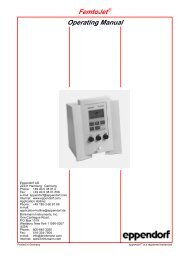DM6000 CFS.qxd:DM6000 CFS - Duke University Light Microscopy ...
DM6000 CFS.qxd:DM6000 CFS - Duke University Light Microscopy ...
DM6000 CFS.qxd:DM6000 CFS - Duke University Light Microscopy ...
You also want an ePaper? Increase the reach of your titles
YUMPU automatically turns print PDFs into web optimized ePapers that Google loves.
Excellent ResultsUnder All ConditionsLeica Microsystems sets a new standard with the integration of theLeica <strong>DM6000</strong> <strong>CFS</strong> fixed stage microscope into the Leica TCS SP5confocal platform.Leica TCS SP5 with integrated fixed stage microscopeLeica <strong>DM6000</strong> <strong>CFS</strong>Features and Benefits• Maximum workspace for mani -pulators and attached pipettes• High collection efficiency due toshort collection path beforedetectors• Integrated change of magnification(0.35x, 1x, 4x) of camera port• Remote control of all microscopefunctions via touch panel• Special booster optic to fill theentrance pupil of the 20x1.0objective• “Dip-in” feature for immersing theobjective• Patented condenser drainagesystem• High microscope and samplestabilityNeurobiological research has a long history not only in measurementsof single cells, but also of thick brain slices. Here morerealistic results can be achieved due to the intact network. Ultimately,accessing the brain directly in a whole animal providesthe most intact environment for conducting measurements onindividual cells. So for optimal results, space for whole animalsamples is an absolute must.Electrophysiological research employs micropipette systems forrecording electrical signals (patch clamp, whole cell recordings),electrical stimulation (intracellular stimulation, synaptic stimulation,soma-stimulation), dye injection and intracellular perfusion. To makesuch measurements effective, the microscope needs to have asmuch space as possible for micropipettes and other manipulators.Searching for the perfect spot in the sample requires a large fieldof view, whilst the precise positioning of the micropipettes requireshigh magnification. Furthermore, high quality confocal image scanningrequires a large numerical aperture for best performance. Tofulfill these experimental prerequisites, a camera with anadjustable magnification and specially adapted objectives areneeded. Any direct manipulation of the system potentially disturbsthe delicate positioning of the micropipettes within the sample.This emphasizes the importance of a remote control for the imagingsetup, providing convenient access to all relevant functions.Finally, recording electrophysiological and imaging data with perfectsynchrony is paramount for correct interpretation. Triggeringimage recording by external events and synchronizing the applicationof stimuli with image scanning down to the single line levelhelps realize sophisticated experimental setups. Online analysisof the resulting data allows on-the-fly adjustment of externalparameters, helping the researcher to get everything just right.The Leica TCS SP5 with the integrated fixed stage microscopeLeica <strong>DM6000</strong> <strong>CFS</strong> gives excellent experimental results under allconditions.2










